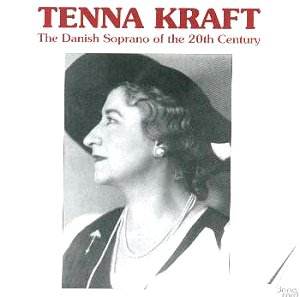If you haven’t heard of Tenna Kraft (1885-1954) you
are in good company. Even as late as 1932 when Fritz Busch was touring
Denmark he is reported to have asked "How is it possible to keep
such an artist from Europe?" Over seventy years later the question
still has validity. Tenna Kraft was born Hortensia Kiristine Sofie Erogine
Frederiksen in 1885 into a tough background in Copenhagen. Gifted but
poor it took persistence to break into the Royal Theatre. After initial
success at twenty-one she wisely sought further study in Berlin and
later still in Paris with no less than Jean de Reske. Returning to Denmark
she was the first native Tosca, Vilem Herold her Cavaradossi (an excerpt
from her Tosca is included). From this time she became prima donna assoluta
at the Theatre and successes followed in numerous works from the standard
repertory – Verdi, Puccini, Gounod’s Faust, Tchaikovsky’s Eugene Onegin
– as well as Danish operas and operetta. In all she sang at the Royal
Theatre from 1906 until her operatic retirement in 1939. Apparently
she was a nervous singer and didn’t learn foreign languages – all the
selections here are sung, as was the custom, in Danish – which may have
limited mobility had she wished to travel; not all artists do.
The selections cover the years 1911, by which time
she was well established and with the Tosca premiere behind her (which
was what must have encouraged Danish HMV to invite her to their Copenhagen
studios for an excerpt) and the Danish songs of 1940 (Henriques and
Weyse amongst them). The Tosca shows her fresh from de Reszke and in
a forward recording with occasional shatter at fortes. At twenty-six
she was still relatively young and the she does show some signs of immaturity
in terms of voice production. There is a distinct lack of depth across
the scale but her top is extremely well produced. Her coloratura in
the La Traviata excerpts is fine though the duets with Herold (1865-1937)
are a little unmatched; her fresh rather silvery tone and his more covered
tenor don’t make for an immediately convincing match though what they
lose in tonal blend they make up for in convincing theatrical response.
In Sempre libera degg’io for instance, or its Danish equivalent,
her runs are smooth, the top notes requiring little obvious mechanical
effort, the tempo easy and pliant. By comparison Herold, a mature, serious
and intelligent artist sounds technically at least somewhat more effortful.
By the time we reach 1920 there is audibly more body
in Kraft’s tone. Where previously her voice could still be a little
undernourished and unsupported now there is a greater range and weight.
The development of her lower voice can be instanced by her accomplishment
in a favourite assumption of hers, Tatyana’s Letter Scene from Eugene
Onegin where the growth in her resources is quite explicit. Her powerful
projection is equally evident in Puccini’s Un bel dì, vedremo
from Madama Butterfly though I have to say I found the excerpt from
La Bohème unconvincing and relatively superficial. She returned
to Tosca in the HMV studios in 1928 but here she was accompanied by
some very swoony salon strings, slide-laden and not many of them from
the sound of it and has to fight hard to efface them. Her control of
dynamics, clarity and intonation are all on show in Vissi d’arte
as well as a kind of parlando portamento, which is very attractive (I’m
less happy with the transfer which has attempted to eliminate clicks
and scratches by removing part of the signal so the surface noise which
accompanies all these recordings suddenly ceases for a second at a time
– off-putting).
With Siegfried Salomon Kraft is on safe penitential
ground. These hymns from Leonora Christina are immediately attractive
if musically only so-so. The first is of rapt simplicity, the second
sturdier, Kraft’s tone taking on a more resonantly devotional resonance.
The excerpt from Don Carlos, nine minutes long, derives from the live
recordings made in Copenhagen in the thirties. Many of these have been
preserved and indeed Danacord have issued them in sumptuous boxes (my
copies of the LP boxes stay on my shelves until the Day of Judgement).
The sound is good, the orchestra quite forward in the balance but this
is a valuable souvenir Kraft caught on the wing. Even if her voice is
quite distant there is an undeniable sense of her conversational ease
and indeed emotional unease, of a convincing dramatic persona. In lighter
material Kraft was equally at home. Thomé’s Simple Aveu is in
rather muffled sound and obbligato cellist Louis Jensen is in lacy mood
but in Flégier’s Les stances Kraft
packs quite a punch. By the time we reach 1934 (by which time Kraft
was nearing fifty) a more matronly edge has crept into the voice as
has indeed – maybe exacerbated by the recording – a certain metallic
hardness. There is also a definable spread at the bottom of her range.
Nevertheless there is great nobility and gravity in Heise’s little Forest
Solitude and equally folk simplicity in the Lange-Müller. Henriques’
To må man være is a charmingly light song but it
gets a sonorous and dignified interpretation from Kraft and an orchestra
conducted by Emil Reesen. She is still agile in 1940, the year after
her operatic retirement – witness the Rantzau - though maybe a little
reserved and the recital ends with her benign assurance in Weyse’s Yonder
in Distant Church Towers.
It’s been a rewarding experience listening to Tenna
Kraft whose name I only knew from the occasional 78. Busch was right
to ask his question. My only concern is the remastering because a number
of tracks have been over cleaned in the way I described earlier. Still,
irrespective of this, a strong recommendation.
Jonathan Woolf
see also review
by Michael Cookson


 BUY
NOW
BUY
NOW